EVERYTHING YOU DIDN’T KNOW ABOUT ENVIRONMENTAL INSURANCE
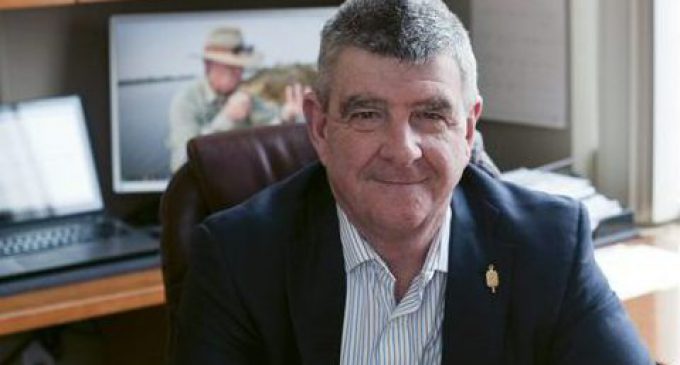
Agency Partners
An expert in the line explains what agents and their clients need to know about this undersold coverage
Sold your clients any environmental insurance lately?
Probably not, observes David Dybdahl, CPCU, MBA, ARM, president of American Risk Management Resources (ARMR), a managing general agency based in Middleton, Wisconsin, that specializes in placing coverage for environmental risks.
“Environmental insurance has less than a 1% market penetration after 30 years of continuous product availability,” Dybdahl says. “Contrary to popular belief, environmental insurance is inexpensive relative to the losses incurred.”
“As a result of the lack of knowledge on the part of retail agents and brokers, hundreds of thousands of commercial insurance buyers are needlessly uninsured for losses associated with contamination events from a wide range of sources.”
—David Dybdahl, CPCU, MBA, ARM
President
This misconception, he remarks, is a key reason that retail agents and brokers are unlikely to recommend that their clients purchase the coverage.
“The constraint in the market for environmental insurance is the product distribution channel: Agents and brokers do not understand pollution exclusions in commercial general liability policies. For decades they have been taught technically inaccurate information about pollution exclusions. Without accurate information about how these exclusions operate, retailers cannot convey the need for environmental insurance to their clients. At ARMR we focus on educating the distribution channel and end users to create demand for our services.”
ARMR takes its education mission seriously. In 1999 it established the Society of Environmental Insurance Professionals as a 501(c)(3) not-for-profit educational organization dedicated to advancing the knowledge and use of environmental insurance. Dybdahl’s daughter, Angela Dybdahl Oroian, serves as executive director and vice president.
What’s more, Dybdahl says, “I teach continuing education classes in environmental insurance across the country; the title of my presentation is ‘Unbelievable Fun with Pollution Exclusions.’ In each class I ask how many agents have sold their commercial property owner clients an environmental policy, and the usual response is one in 100. That percentage increases significantly after agents have completed the class.”
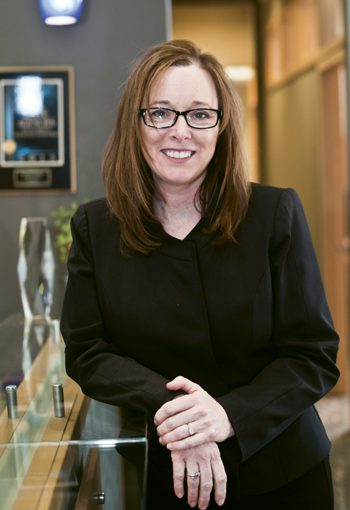
“Almost every agency writes farms, commercial properties, contractors, plumbers, HVAC techs, and transportation risks. As a result, these agencies have opportunities to increase sales by presenting environmental insurance to clients, and to protect their E&O by having those conversations.”
—Kris Rasmussen, CPCU, CIC
Customer Service Representative
Legal woes
What happens when a client is found liable for a pollution-related loss and then discovers that he or she has no coverage?
In a word, says Dybdahl: litigation.
“As a result of the lack of knowledge on the part of retail agents and brokers, hundreds of thousands of commercial insurance buyers are needlessly uninsured for losses associated with contamination events from a wide range of sources,” he says. “That leads to coverage litigation. It also can lead to errors and omissions claims for failure to provide coverage.
“In the last year, members of the ARMR staff have served as expert witnesses in $1.2 billion in litigated insurance coverage on environmental damage claims,” Dybdahl says. “Of the $1.2 billion, only $25 million involved an actual environmental insurance policy. All the rest of the litigation involved policies that contained a pollution exclusion.”
Dybdahl warns of an emerging exposure that further underlines the need for environmental insurance protection. “We’re seeing a rapid increase in mold claims on commercial properties. More than 99% of commercial properties are currently uninsured or woefully underinsured for any loss that involves even a speck of fungus, mold, or bacteria. The typical mold/bacteria sub-limit on a property policy is $10,000; the average mold-related loss on commercial property is $250,000. The CGL provides no coverage, nor does the insurer have a duty to defend.”
Opportunities abound
“The new business opportunities in environmental insurance are at an all-time high today,” Dybdahl asserts. “The most underserved market is commercial property owners and managers.”
Environmental insurance is written largely in the excess-surplus market by some 40 carriers. “New players are entering the market, so there’s plenty of competition and capacity,” Dybdahl remarks. “Rates are favorable for insureds, and there’s no better time for retailers to learn about the coverages and offer them to their clients.”
Earlier this year ARMR introduced an environmental insurance product designed to insure highly protected commercial properties at an affordable cost. The offering combines boots-on-the-ground loss control services with customized environmental insurance that includes coverage for mold and bacteria in addition to traditional pollutants.
“The operative word in a pollution exclusion is ‘contamination,’” Dybdahl says, “so if you have a client whose operation could contaminate something, the pollution exclusion is likely going to be a problem. Examples of excluded events are leakage of a substance into a water source and paint overspray. Well over 99% of the businesses that need our product don’t have it. The need for the coverage expanded significantly when water was effectively made a pollutant. After three days of excessive moisture on drywall, you have a mold claim. That used to be treated as an ensuing loss from a covered peril, but that’s no longer the case. Then, insurers introduced the mold exclusion with a sub-limit and an anti-concurrent causation clause.
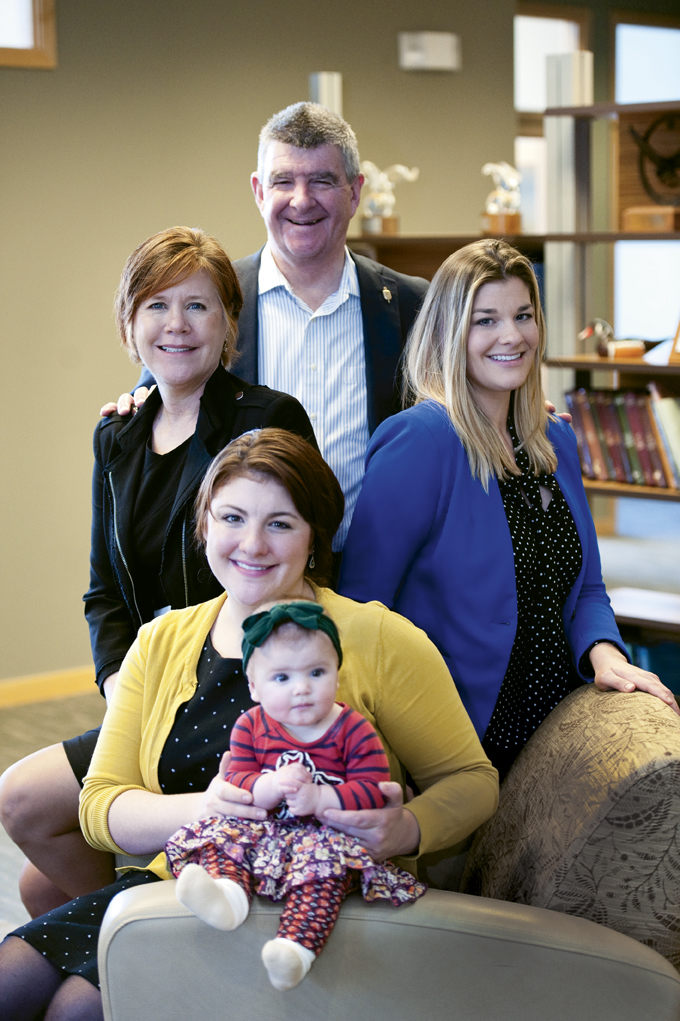
David Dybdahl and wife/CFO Cynthia Statz pictured with daughters Kari, Executive Vice President, Director of Operations and Angela Dybdahl Oroian, Marketing Director holding her daughter Ariya.
“We insure over 1,000 fire and water restoration operations, and we’ve known for over a decade that the technically excluded mold claims were being paid as ‘water damage’ claims with a wink and a nod from the adjuster. That has changed. Insurers are coming to grips with the fact that if they ignore the anti-concurrent language in fungus or bacteria exclusions, they undermine their ability to deny flood claims on property policies. Both exclusions are based on the same template.
“It’s tough for the retailer because what used to be covered no longer is,” Dybdahl observes. “Not selling your client environmental insurance is different from not selling an employment practices liability policy. That exposure was never covered in the CGL, whereas mold was covered for the full limit and now is not. That’s what’s driving growth in the demand for environmental insurance. We see commercial properties being the number one source of growth in the environmental product line.”
As noted earlier, retail agents and brokers simply are not offering environmental insurance to their clients. “Even if they did try to sell it, their chances of getting it right are poor because the policies weren’t designed for indoor exposures,” Dybdahl explains. “You can’t take a policy that was designed to insure a landfill and expect it to work in an office building. Agents need to vet their environmental insurance vendors. After all, if an agent has not had the opportunity to learn about pollution exclusions over the years, where did their vendors learn it?”
Knowledge and expertise
The members of the 30-person ARMR staff possess specialized expertise in the intricacies of environmental insurance and can use that expertise to educate retailers and then help them explain the coverage to clients. “The reason we’re successful in this market is that we provide the subject matter expertise that is required to function efficiently in the product line,” Dybdahl says. “Our most common call from retailers is ‘Please send me an application for pollution insurance; I want to propose it to my client.’ We give them a big slowdown because unless the client understands what the insurance is for, he or she won’t buy it.
“For the agents who follow our sales protocols, their hit ratios on new business are above 30%,” Dybdahl continues. “For underwriters, the hit ratio is about 10%, so we triple the chances that the client will buy. For restoration contractors, the hit ratio is 90%. On our ARMR HPR product for commercial property, the hit ratio is about 50% on the first proposal, and we pick up quite a few more the second time around.
“Most insurance buyers don’t like to be uninsured,” Dybdahl says. “Agents think that buyers want low premiums. My experience is that buyers want to be insured so they won’t be surprised by a $400,000 water damage loss that’s not covered.”
ARMR has 29 employees, of whom about half are age 30 or under. The firm operates an internship program for college students, who work part time while they’re in school and full time in the summer if they choose. Upon graduation they can join the firm and hit the ground running, thanks to their years of training in environmental exposures and coverages.
“I can’t hire people who know how to do environmental insurance in the wholesale space,” Dybdahl says. “The only way to build our firm is through the constant addition of motivated young people. We invest heavily in their education, and we encourage them to acquire the CPCU and CIC designations. To be successful in environmental insurance you have to be strong in traditional insurance. You need to know how to fill the coverage gaps left by exclusions in the commercial property and CGL policies.”
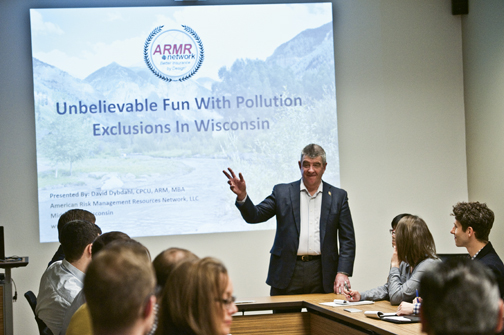
David Dybdahl leads a training seminar in the Middleton office’s conference room.
A motivated Millennial
Nathan Millonzi, a 2017 graduate of the University of Wisconsin at Madison, participated in ARMR’s internship program last summer and upon graduation accepted a full-time position with the firm as an account specialist.
“I had an internship the summer before working for Aflac as a supplementary sales agent, which opened my eyes to the insurance industry and how insurance can truly benefit people,” Millonzi says. “I knew a few people who worked at ARMR (including my brother), which really brought ARMR to my attention (and when you hear about a company that has a keg and partakes in Beer:30 on Fridays, they’re hard to forget!). The position specifically interested me because of its smaller, more ‘family-like’ size, and I found it attractive that ARMR specializes in a unique line of insurance that I find more interesting and challenging than the standard lines.”
As an intern, Millonzi says, “I was in a supportive role for production teams (producers and account managers) and handled tasks that ranged from quote preparation, policy review, and recording of activities in our database system, while being trained in environmental exposures and coverages.”
As an account specialist, Millonzi works as part of the CSR pool where his responsibilities include preparing insurance proposals, marketing renewal replacements, managing day-to-day service needs of accounts, completing certificates of insurance, and other duties.
How does Millonzi like working for a company where half the staff is under age 30?
“It’s a lot of fun,” Millonzi responds. “It’s a great environment to be a part of as a lot of people are at a similar stage in life (just out of college, getting engaged/married, first full-time job). Working with such a young crew definitely eases the transition from college to full-time employment and the pressures it imposes. It’s almost like being in high school or college again where everyone is roughly the same age, but without the cliques and with a paycheck. Being the youngest full-time employee, it’s great to see how others just a few years ahead of me have progressed at work and to be able to hear about their experiences. However, it’s not only the under-30 group but everyone at ARMR who make it such a great place to work.”
Asked about his career goals, Millonzi says: “Someday I dream of having a business of my own that serves a genuine purpose for its customers, but until I figure out what that will be I just strive to get better at what I am doing right now. There is never a time to stop learning, and only being a full-time employee for a month now, my main goal is to soak up as much knowledge as possible. Short term, I would like to move into a more hands-on account manager position and take on greater responsibility in production. Until then I look forward to learning as much as possible so that when that day comes I will be ready.”
A veteran’s view
Kris Rasmussen, CPCU, CIC, a 20-year veteran of the insurance business, spent her Millennial days working in her family’s agency.
“I began working at age 12 in my dad’s independent agency,” Rasmussen says. “After graduating from UW-Madison I spent two decades working for carriers in claims, underwriting, and marketing, and as a retail independent agent. A year ago I had the opportunity to join ARMR as a member of the sales service team where I coordinate the CSR pool.”
What attracted Rasmussen about the opportunity to join ARMR?
“I knew Dave Dybdahl was a pioneer in environmental insurance and had heard of ARMR’s outstanding reputation as a wholesale broker. I’ve always tried to be a student of the industry and was excited to experience a whole new side of insurance. ARMR embraces the value of enabling employees to work remotely. As a working parent, that is a Godsend.”
We asked Rasmussen how she would characterize the differences between ARMR and other insurance outlets.
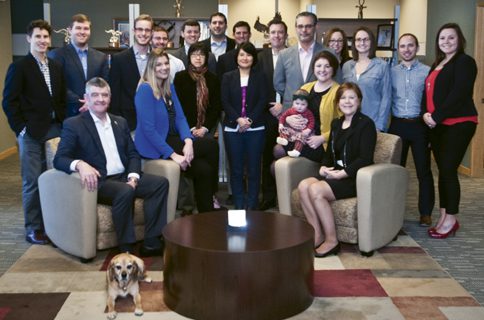
ARMR staff in the company “living room”
“One of the differences I’ve seen is how specialty and surplus lines present flexibilities that standardized insurance does not. ARMR staff has worked with companies to change policy language to fix coverage gaps and can work with underwriters to tailor manuscripted endorsements for individual clients.
“I think agents may avoid specialty coverages because of lack of markets or expertise. Agents need not be intimidated about selling environmental insurance if they work with ARMR. Just as retail prospects choose agents for their expertise in certain areas, agents who choose ARMR over generalist wholesalers to place environmental business have access to experts who will walk through the whole process with them and serve as advocates and advisors. Surplus lines is not automated like standard lines, which does involve some extra steps, but the sales opportunities are worth the effort.
“Every agency has clients with environmental exposures. Pollution isn’t just barrels of toxic chemicals in a landfill or lead and asbestos in old houses. Mold, bacteria, carbon monoxide, odors, and even manure—here in America’s Dairyland—have been classified as pollutants. Almost every agency writes farms, commercial properties, contractors, plumbers, HVAC techs, and transportation risks. As a result, these agencies have opportunities to increase sales by presenting environmental insurance to clients, and to protect their E&O by having those conversations.
“ARMR is also above the curve for the industry in finding ways to build a pipeline of young talent. In my years working with agencies and our state insurance associations, I’ve seen how our collective agency force is struggling to attract young people at a time where the average age of insurance agents has risen to 55-plus. I’ve always been one of the youngest where I’ve worked, but here I’m one of the oldest at age 48. My coworkers don’t get my ’80s jokes, but they are keeping me young.”
For more information:
ARMR Network
www.armr.net
By Elisabeth Boone, CPCU











